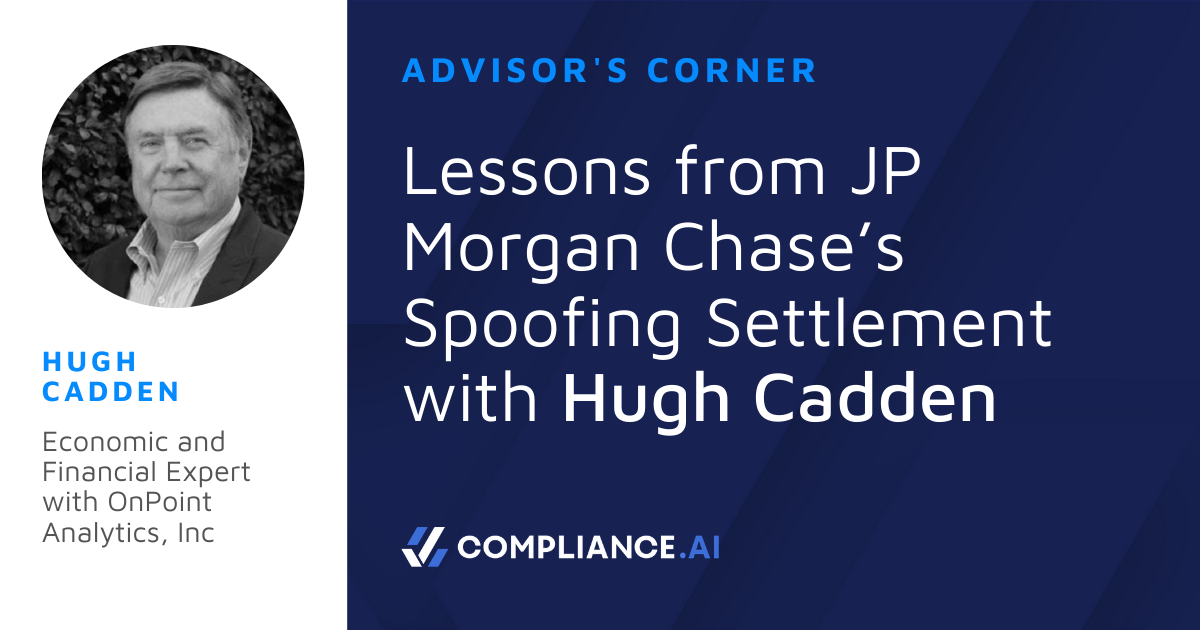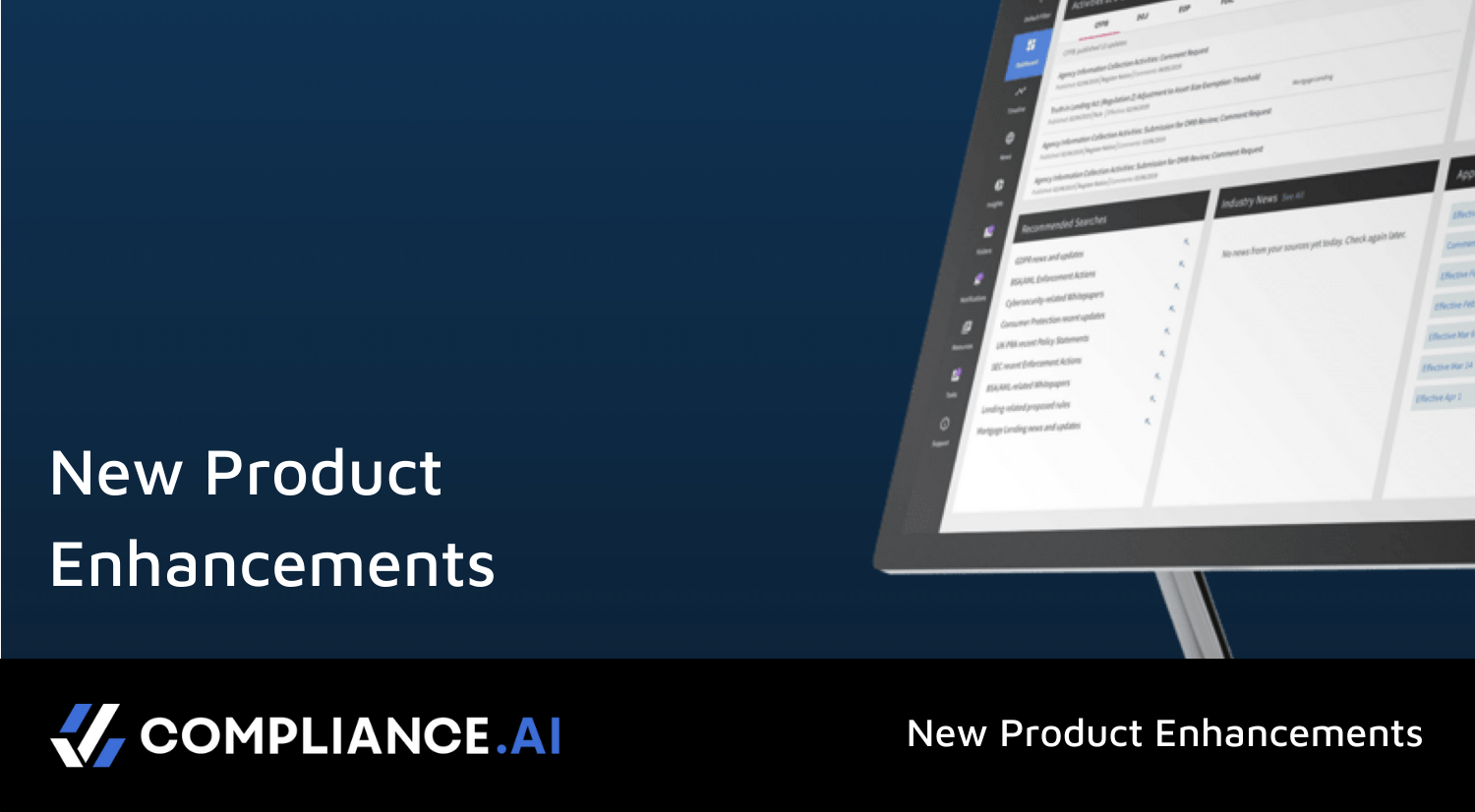Ronjini Joshua (RJ) – Hello, welcome to compliance AI Advisors Corner. Today we’re speaking with Hugh Cadden, a senior consultant with Onpoint Analytics and an expert in derivative markets. Thank you, Hugh, for joining us today. So, today we’re gonna talk a little bit about the spoofing and JPMorgan case, from 2020. And obviously, how it plays into 2021. But I think the first big question that we can really address is what is the big kind of, it would be great if you can give a big overview of the JPM spoofing settlement, but also the significance of the settlement itself and the context around enforcement and compliance.
Hugh Cadden(HC) – The importance of or the significance of the JPMorgan spoofing settlement is, is it’s really the capstone of the spoofing taskforce effort over the last three years, and of course, it’s a $920 million number, so you might call it a mega settlement or mega fine. And it involved the joint task force, which included the CFTC sec, FBI, and the Department of Justice. So it was a joint action, which was important. It was extremely large, it was the largest find that the CFTC has achieved with respect to spoofing. So that was another landmark issue. And it basically accounted for the vast majority of the fines collected by the CFTC in 2020. So it was large. And it also basically, as the, as the capstone basically puts this, they put the stripe on the field with respect to spoofing.
RJ – Yeah, I have a lot of interesting questions around this because it is such a large settlement. And it brings up a lot of questions about the efficiency of enforcement’s like these. What does what is the JP Morgan’s spoofing settlement tell us about kind of the overall overall market enforcement and deterrence going forward?
HC – Well, I think it tells us a lot. But before I get into that, maybe I might just give a give a sketch of the terms.
RJ – Oh yeah, please, please. Of course,
HC – Spoofing of course, is basically the intentional entering of orders to cancel them before they’re executed. And it’s a manipulation tool or factor that comes into play in trading, and it was part of the Dodd Frank legislation. So basically, JP Morgan engaged over an eight year period, it was 2008 to 2016. With these spoofing activities off their trading desk, and it would involve hundreds of 1000s of spoofing orders. And so it’s very significant, very broad in the context of their trading operation. And the settlement basically reflects that. It ended up to be a global and $920 million settlement, which when you break it down, essentially about $436 million was the monetary funding, but also there was $350 million or so that was a sort of a restitution or Victim Compensation Fund element. And then finally $172 million component that was a disgorgement. provision. So there it was significant and broad in terms of, of the different types of relief that came into play. And one of the elements that that was also interesting is that in the context of the settlement, they do the background on it, and part of that background was the the supervisory lapses or failures. Early period, JP Morgan did not have proper analytics to even do the compliance review. And then I think they mentioned in 2014, they put into place the analytics, and then they failed to follow them, when the red flags starting to surface are what you would call exception reports. So there was sort of a dual failure there, but those that’s the broad brush of the settlement. And then in addition, with the Department of Justice, there was a difference. prosecution agreement. So with a deferred prosecution agreement, I think the term was three years. So that came into play. And that was a criminal. I believe wire fraud violation. Lots of elements. But those that’s that’s the broad brush of it.
RJ – Yeah, I mean, it is a broad brush. It’s very, there’s a lot of things going on in here. So again, so let’s kind of go go back into, you know, what is the saying about overall market enforcement? I think that outline is really nice to have, as we as we dive into this conversation a little bit deeper. What do you find are really the salient points of this particular settlement?
HC – Well, I think it raises some issues about the effectiveness of the deterrence. I think I had discussed with you previously, the fact that JP Morgan, entered into a similar agreement in 2015. And the 2000, that was, I believe, a $500 million dollar fine. It was also a deferred prosecution agreement, and it related to an antitrust, bid rigging on the euro and the dollar trading. And so that basically raises the issue, obviously, well, how much of a deterrence is this? And I think that’s one of the things that comes up with respect to the settlements in this this space. This it raises the question, what is the effect of deterrence? And I’ve always been of a of a mind that with some of the big players and the most egregious situations that the the government has to consider the potential for trading prohibitions, they have the authority to do this, they can have a temporary or permanent trading probation. And in my opinion, that’s probably the most effective measure in terms of sanctions. And of course, you know, it’s almost like a get out of jail free card with the situation, the the fines are, in this case, pretty big.
RJ – You would think they’re so phenomenal that it would it would deter someone.
HC – They’re big, but you have to view them in the context of these are these organizations trading profits? And, and the role that that trading plays in that. And, you know, the situation is, you know, I would guess that JP Morgan’s trading profits, probably are in the neighborhood of maybe annually, 20 billion thereabouts. So you can see the magnitude of that. And then the, the issue is, the role of trading plays in that. So if a violator had to spend time outside the market, whether it’s a month, or two months or three months, it’s huge. It’s a very significant sanction. And that definitely will get the attention of everybody. Traders do not like to be out of the market, and an organization like JP Morgan, or any other major bank, and they’re not the only ones that were involved in this activity, you know, then it included other banks with their trading operation. So it’s significant, and I think that the government should consider that in terms of their tool when they’re dealing with the returns.
RJ – Yeah, so there, there have been quite a few spoofing settlements with major banks and trading firms. But what are the what are the downsides of the settlements? I mean, you talked about time away. And I think that’s an interesting point to make. What are what are the other downsides for of this elements for these organizations?
HC – The big one in my mind relates to the damages. This settlement has a what’s called the Victim Compensation Fund, on basically, under this particular settlement, you know, $311 or so million dollars is set aside over Department of Justice fraud division, and claimants can file a claim and hopefully recover whatever losses incurred, and that’s very positive in one way, but it has a downside to it because the 311 million which has been identified as the restitution fund is driven by what the government has determined to be the damages. And in that they use a model and they use they’re, they’re looking at discrete trades and the potential loss that the party on the other side of that trade incurred. And in my opinion, that may be narrowing the damages to the detriment of the of the actual victim. And the reason being is that if JP Morgan or any othe spoofer engaged in hundreds of 1000s, of trades, it has a greater impact on the market the overall market because I believe that you have to look beyond the discrete trades, particularly if there’s a duration to the manipulation, to the extent that there’s a duration aspect of the manipulation of the spoofing, then you’ve got to look at the whole trading segment and see what the actual damages are. And the government’s not doing that in these settlements. In fact, the follow on class actions that have been filed against the banks, just recently, in one of them, the defendants raised this issue, they said,” Oh, the damages are only this discrete trade,” and you have to be on the opposite side of that trade to have been damaged.
RJ – I imagine that that time and resources to investigate it thoroughly, probably would be crazy as well.
HC – Well, yes and no, because one of the other aspects about spoofing is you’re looking at all the all the market data is readily available. Sure, yeah. And so with that market data, then you put it in, this is where the FinTech comes in, you can put it into different models, and you can do the analytical work to determine what they what the impacts are. And the point here that that bothers me a little bit of concern is that when you look at the discreet trading, it’s narrowing those damages. And so what impact that narrowing of the damages has, when it comes to the class follow on class actions. That’s an important issue. I think that the government should be mindful of that
RJ – Well, I think this gives us a really good overview. And obviously, there’s a lot more to be said about this particular case, and many others like it. But what do you think, you know, when we see cases like these in the news, and we’re looking at the enforcements, what are the key takeaways for compliance professionals and trading firms?
Hugh Cadden – I would say for the compliance professional, and I would include in that, counsel and operations as well. The key takeaway is, first that I would say that the government has basically upped their game with respect to trade analytics, they’re they’re basically demonstrating through these cases that, that they’re getting a handle on being able to analyze the the trading in the context of spoofing. So the compliance, people have to be aware of that now, in most major institutions and major trading firms they’ve come up the curve as well. And they’re probably a little bit ahead of the government. But they’ve come up the curve, and they’re, they’re doing their analytics in terms of looking for spoofing off their trading desks and the like. So that’s important. And it puts it puts the premium on, basically your controls, your trade analytics, your supervision, and your training. So those are those are the big, big items that you can take away from this. And that’s what the compliance departments and principals should be focusing on.
RJ – Now. That’s, that’s fantastic. And what about for regulators? What are what are the key takeaways there? And you know, they’re a little bit different there.
HC- Yeah, I would say that the key takeaways for the regulators are basically I think, that as they approach these settlements, they have to think about the deterrence aspect. And they have to consider, in appropriate cases, trading prohibitions, and I know that that’s a big item for the regulators because it means that they’re going to have to try cases. And it’s very difficult to approach these settlements with trading prohibitions with the major players because their trading is so integral to their operations and their bottom line, but the reality of it is that in particular cases they’re going to have to, they’re going to have to face that, that choice. But I think that case by case, they should consider trading prohibitions, when they can. That’s that’s one. And then the second one is that I think that apart from the deterrence, one of the elements that jumps out to me in these cases is that the violations are over long periods of time, if you look at all of these settlements, and not just the ones in the precious metals, which we’re talking about here, of course, but other violations that have come along, whether they’re record keeping but or different trades situations, the violations are for long periods of time, which makes me think that the regulators need to focus a little better on their review process and their their auditing, because these are things that you would hope would be picked up, you know, in a much shorter period of time. So that would be the other item The other takeaway, from my perspective, in other words, is they’ve got to think about, you know, who’s watching the shop on trade practice review and the light so that these things would surface quicker and come up.
RJ – Do you think this case in particular, and obviously, this is one of the bigger ones that we’ve ever seen? So how do you think this case will play into the future of regulating and how we’re, you know, we’re diving into a new year 2021? What do you think the impact of that case will be coming up this year?
HC – Well, I think basically, you know, I noticed on my Compliance AI dashboard, some time ago, I picked up the annual report, you know, then the 2020, Division of Enforcement CFTC annual report. And they they detailed all of their activity over the year. And they also basically gave a little forward comment about the things that they were looking at, and two of them were continuing the emphasis on spoofing and manipulation, and the other one was independent responsibility, meaning that they would go after the individuals. Now this is another area where they have to get at where I feel that they need to improve in in terms of going after the individuals. They have to go up to the line. In in most all of these spoofing cases, they’ve gone after the the traders on the desk. And basically, they haven’t gone up to, you know, the the more senior levels with respect to potential culpability. But anyway, those are the two items they were looking to go forward. I would say it’s probably judging from their annual report, it’s probably going to be looked a lot like last year, there’s going to be still a large emphasis on spoofing and manipulation for market integrity and they’re basically going to be looking at supervision, which is another point that the compliance people have to think about. They’ve got to basically get on to their supervision and make sure that they implement what they put into place and the rules and regulations and controls, but that’s the direction they’re going in. Lastly, I think that what they might consider is I think that they should push some of the responsibility on to the exchanges. You know, the the regulators are just, they’re basically underfunded to the extreme. And as they’re under funding, the markets are expanding greatly. And the exchanges have a lot of expertise. Their systems are excellent. And they have a lot of resources, and they have the primary responsibility for oversight of their members, and all of these major players are members. So one of the things that I think might be beneficial and enhance market integrity would be to have the exchanges take the lead on some of these manipulation cases and have them deal with the issue of putting restrictions on their members trading. That might be a deterrent.
RJ – That’s interesting. Yeah, that’s that’s a good insight. Thank you so much. Just kind of breakdown of this case. And I know there’s so much more that can be said. But we really appreciate your time and your expert advice and insights here. I hope everyone can take away. We’ll have some show notes. But thank you so much Hugh Cadden for joining us. And have a great day and stay safe.
HC – Okay, thank you.
Hugh Cadden is an advisor to Compliance.ai and a senior consultant with Onpoint Analytics





